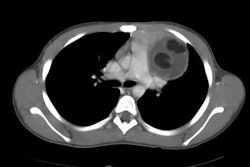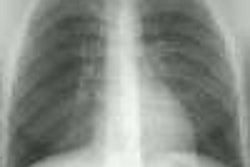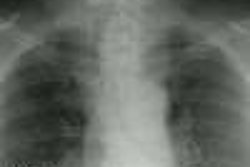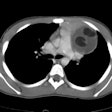AJR Am J Roentgenol 1997 Oct;169(4):985-990. Mediastinal mature teratoma: imaging features.
Moeller KH, Rosado-de-Christenson ML, Templeton PA
OBJECTIVE: The purpose of this study was to characterize the cross-sectional imaging features of mediastinal mature teratomas. MATERIALS AND METHODS: Sixty-six cases of mediastinal mature teratoma were retrospectively reviewed, noting clinical, radiologic, surgical, and pathologic findings. The patient population consisted of 38 females and 28 males who were 1 week to 67 years old (mean age, 23 years 10 months). RESULTS: Forty-six patients presented with symptoms, predominantly chest pain, dyspnea, and cough. Twenty patients were asymptomatic. Fifty-four tumors were found in the anterior mediastinum, two in the posterior mediastinum, one in the middle mediastinum, and nine in multiple compartments. CT studies (n = 66) showed masses of heterogeneous attenuation with varying combinations of soft tissue, fluid, fat, and calcium. Soft-tissue attenuation was observed in 66 tumors (100%), fluid in 58 tumors (88%), fat in 50 tumors (76%), and calcification in 35 tumors (53%). The most frequent combination of attenuations was soft tissue, fluid, fat, and calcium, which was noted in 26 masses (39%). The combination of soft tissue, fluid, and fat was seen in 16 tumors (24%); and the combination of soft tissue and fluid was seen in 10 tumors (15%). Fat-fluid levels were seen in seven masses (11%). CONCLUSION: Mediastinal mature teratoma typically manifests on CT as a heterogeneous anterior mediastinal mass containing soft-tissue, fluid, fat, or calcium attenuation, or any combination of the four. Fluid-containing cystic areas, fat, and calcification occur frequently. Cystic lesions without fat or calcium were seen in 15% of tumors. Fat-fluid levels, considered highly specific for the diagnosis of mediastinal mature teratoma, are uncommon. CT is the imaging technique of choice in the evaluation of these lesions.
PMID: 9308448, MUID: 97453828




